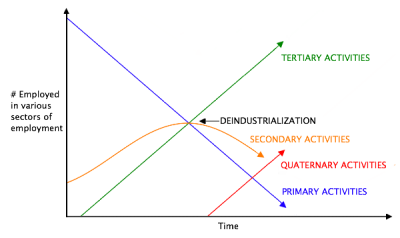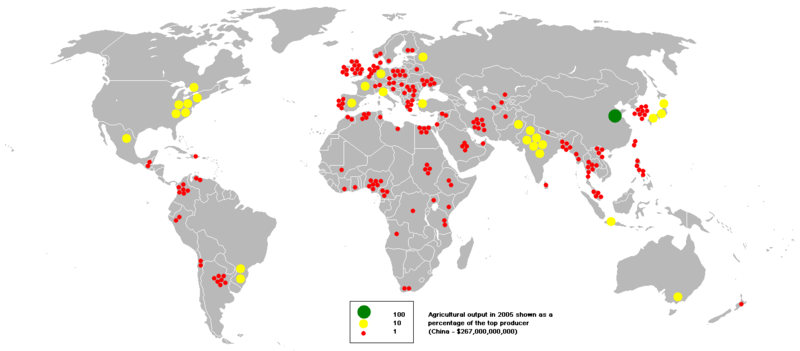"History of Farming and Agriculture"
Etymology of "Agriculture
The word agriculture is the English adaptation of Latin agricultūra, from ager, "a field",[5] and cultūra, "cultivation" in the strict sense of "tillage of the soil".[6] Thus, a literal reading of the word yields "tillage of a field / of fields".
Overview
Agriculture has played a key role in the development of human
civilization.
Until the
Industrial Revolution, the vast majority of the human
population labored in agriculture. Development of agricultural
techniques has steadily increased agricultural productivity, and
the widespread diffusion of these techniques during a time
period is often called an
agricultural revolution. A remarkable shift in agricultural
practices has occurred over the past century in response to new
technologies. In particular, the
Haber-Bosch
method for synthesizing
ammonium
nitrate made the traditional practice of recycling nutrients
with crop
rotation and animal
manure less
necessary.
The percent of the human population working in agriculture
has decreased over time.

Clark's Sector Model
Synthetic nitrogen, along with mined rock phosphate, pesticides and mechanization, have greatly increased crop yields in the early 20th century. Increased supply of grains has led to cheaper livestock as well. Further, global yield increases were experienced later in the 20th century when high-yield varieties of common staple grains such as rice, wheat, and corn (maize) were introduced as a part of the Green Revolution. The Green Revolution exported the technologies (including pesticides and synthetic nitrogen) of the developed world out to the developing world. Thomas Malthus famously predicted that the Earth would not be able to support its growing population, but technologies such as the Green Revolution have allowed the world to produce a surplus of food.[7]
Many governments have subsidized agriculture to ensure an
adequate food supply. These
agricultural subsidies are often linked to the production of
certain commodities such as
wheat, corn (maize),
rice,
soybeans, and
milk. These
subsidies, especially when done by
developed countries have been noted as
protectionist, inefficient, and environmentally damaging.[8]
In the past century agriculture has been characterized by
enhanced
productivity, the use of synthetic
fertilizers
and pesticides,
selective breeding,
mechanization,
water
contamination, and
farm
subsidies. Proponents of
organic
farming such as
Sir
Albert Howard argued in the early 1900s that the overuse of
pesticides and synthetic fertilizers damages the long-term
fertility of the soil. While this feeling lay dormant for
decades, as
environmental awareness has increased in the 2000s there has
been a movement towards
sustainable agriculture by some farmers, consumers, and
policymakers. In recent years there has been a backlash against
perceived
external environmental effects of mainstream agriculture,
particularly regarding water pollution[9],
resulting in the
organic
movement. One of the major forces behind this movement has
been the
European Union, which first certified
organic food
in 1991 and began reform of its
Common Agricultural Policy (CAP) in 2005 to phase out
commodity-linked farm subsidies[10],
also known as
decoupling. The growth of
organic
farming has renewed research in alternative technologies
such as
integrated pest management and
selective breeding. Recent mainstream technological
developments include
genetically modified food.
As of late 2007, several factors have pushed up the price of
grain used to feed poultry and dairy cows and other cattle,
causing higher prices of wheat (up 58%), soybean (up 32%), and
maize (up 11%) over the year.[11][12]
Food riots have
recently taken place in many countries across the world.[13][14][15]
An epidemic
of stem rust
on wheat caused
by race Ug99 is
currently spreading across Africa and into Asia and is causing
major concern.[16][17][18]
Approximately 40% of the world's agricultural land is seriously
degraded.[19]
In Africa, if current trends of soil degradation continue, the
continent might be able to feed just 25% of its population by
2025, according to
UNU's Ghana-based Institute for Natural Resources in Africa.[20]
History
Main article:
History of agriculture
A Sumerian
harvester's sickle made from baked clay (ca. 3000 BC).
Since its development roughly 10,000 years ago, agriculture has
expanded vastly in geographical coverage and yields. Throughout
this expansion, new technologies and new crops were integrated.
Agricultural practices such as
irrigation,
crop
rotation,
fertilizers, and
pesticides
were developed long ago, but have made great strides in the past
century. The
history of agriculture has played a major role in
human history, as agricultural progress has been a crucial
factor in worldwide
socio-economic change.
Wealth-concentration
and
militaristic specializations rarely seen in
hunter-gatherer cultures are commonplace in societies which
practice agriculture. So, too, are arts such as epic literature
and monumental architecture, as well as codified legal systems.
When farmers became capable of producing food beyond the needs
of their own families, others in their society were freed to
devote themselves to projects other than food acquisition.
Historians and anthropologists have long argued that the
development of agriculture made civilization possible.
Ancient origins
Further information:
Neolithic Revolution
An
ancient Egyptian farmer
Source:
http://www.kingtutone.com
The Fertile Crescent of the Middle East, Egypt, and India were sites of the earliest planned sowing and harvesting of plants that had previously been gathered in the wild. Independent development of agriculture occurred in northern and southern China, Africa's Sahel, New Guinea and several regions of the Americas. The eight so-called Neolithic founder crops of agriculture appear: first emmer wheat and einkorn wheat, then hulled barley, peas, lentils, bitter vetch, chick peas and flax.
By 7000 BC, small-scale agriculture reached Egypt. From at least 7000 BC the Indian subcontinent saw farming of wheat and barley, as attested by archaeological excavation at Mehrgarh in Balochistan. By 6000 BC, mid-scale farming was entrenched on the banks of the Nile. About this time, agriculture was developed independently in the Far East, with rice, rather than wheat, as the primary crop. Chinese and Indonesian farmers went on to domesticate taro and beans including mung, soy and azuki. To complement these new sources of carbohydrates, highly organized net fishing of rivers, lakes and ocean shores in these areas brought in great volumes of essential protein. Collectively, these new methods of farming and fishing inaugurated a human population boom dwarfing all previous expansions, and is one that continues today.
By 5000 BC, the Sumerians had developed core agricultural techniques including large scale intensive cultivation of land, mono-cropping, organized irrigation, and use of a specialized labour force, particularly along the waterway now known as the Shatt al-Arab, from its Persian Gulf delta to the confluence of the Tigris and Euphrates. Domestication of wild aurochs and mouflon into cattle and sheep, respectively, ushered in the large-scale use of animals for food/fiber and as beasts of burden. The shepherd joined the farmer as an essential provider for sedentary and semi-nomadic societies. Maize, manioc, and arrowroot were first domesticated in the Americas as far back as 5200 BC. [21] The potato, tomato, pepper, squash, several varieties of bean, tobacco, and several other plants were also developed in the New World, as was extensive terracing of steep hillsides in much of Andean South America. The Greeks and Romans built on techniques pioneered by the Sumerians but made few fundamentally new advances. Southern Greeks struggled with very poor soils, yet managed to become a dominant society for years. The Romans were noted for an emphasis on the cultivation of crops for trade.
References
[edit]
Notes
^ Marketwatch (2007)
Plastics are Green in More Ways Than One.
^ BIO (n.d.)
Growing Plants for Pharmaceutical Production vs. for Food and
Feed Crops.
^
International Labour Organization
Key Indicators of the Labour Market 2008,
p.11-12
^ "https://www.cia.gov/library/publications/the-world-factbook/geos/XX.html".
https://www.cia.gov/library/publications/the-world-factbook/geos/XX.html.
^
Latin Word Lookup
^
Latin Word Lookup
^ New York Times (2005)
Sometimes a Bumper Crop is Too Much Of a Good Thing
^ New York Times (1986)
Science Academy Recommends Resumption of Natural Farming
^ The World Bank (1995)
Overcoming Agricultural Water Pollution in the European Union
^ European Commission (2003)
CAP Reform
^ New York Times (2007 September)
At Tyson and Kraft, Grain Costs Limit Profit
^
Forget oil, the new global crisis is food
^
a
b
Riots and hunger feared as demand for grain sends food costs
soaring
^
a
b
Already we have riots, hoarding, panic: the sign of things to
come?
^
a
b
Feed the world? We are fighting a losing battle, UN admits
^
Millions face famine as crop disease rages
^ "Billions
at risk from wheat super-blight". New Scientist Magazine
(issue 2598): 6–7. 2007-04-03.
http://environment.newscientist.com/channel/earth/mg19425983.700-billions-at-risk-from-wheat-superblight.html.
Retrieved on 2007-04-19.
^ Leonard, K.J.
Black stem rust biology and threat to wheat growers, USDA
ARS
^
Global food crisis looms as climate change and population growth
strip fertile land
^
Africa may be able to feed only 25% of its population by 2025
^ "Agriculture's
Sustainable Future: Breeding Better Crops". Scientific
American. 2009-07-15.
http://www.scientificamerican.com/article.cfm?id=agricultures-sustainable-future.
Retrieved on 2009-08-07.
^
Farming older than thought | University of Calgary
^ The
Impact of the Potato. History Magazine
^
Super-Sized Cassava Plants May Help Fight Hunger In Africa.
The Ohio State University
^
Maize Streak Virus-Resistant Transgenic Maize: an African
solution to an African Problem. Scitizen. August 7, 2007
^
a
b
c
d
e Tilman D, Cassman KG, Matson PA, Naylor R, Polasky S
(August 2002). "Agricultural sustainability and intensive
production practices". Nature 418 (6898): 671–7.
doi:10.1038/nature01014
. PMID
12167873.
^
a
b
c Tilman D, Cassman KG, Matson PA, Naylor R, Polasky S
(August 2002). "Agricultural sustainability and intensive
production practices". Nature 418 (6898): 671–7.
doi:10.1038/nature01014
. PMID
12167873.
^ USDA NAL Special Collections.
South China explorations: typescript, July 25, 1916-September
21, 1918
^ USDA NAL Special Collections.
Dorsett-Morse Oriental Agricultural Exploration Expedition
Collection
^ USDA ERS.
Agricultural Productivity in the United States
^ The Food Bubble
Economy. The Institute of Science in Society.
^
"Global Water Shortages May Lead to Food Shortages-Aquifer
Depletion", Lester R. Brown
Some of the prior text is a modified version of Wikipedia pages,
and thus the work is released under CC-BY-SA, http://creativecommons.org/licenses/by-sa/3.0/.
For further information, please refer to the
legal code of the CC-BY-SA License.

